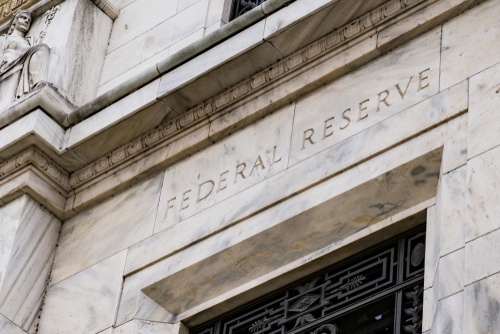Blog
June Investment Review: Federal Reserve takes a pause
by Haith Nori
June saw global markets deliver mixed performances, albeit generally reacting positively to the US Debt ceiling issue being resolved at the end of May. A key aspect during this month has been central banks taking their next steps to control inflation. Japanese equities have reached their highest point since August 1990, up c.29% since the start of 2023 with Warren Buffet spotting value in the country and increasing the size of his existing positions in several of Japan’s largest firms. Back in the US, Apple has now reached a market capitalisation of over $3 trillion for the first time ever, assisting with the continued technology rally since the beginning of the year.
On 13th June US CPI data was released for the 12 months ending in May of 4%, 0.9% lower than that of April, still on the downward trend since June 2022 (9.1%). US. Federal Reserve Chair Jerome Powell is still fixated on achieving a 2% inflation target. On 16th June Eurozone CPI data was released for the 12 months ending in May of 6.1%, a reduction from April’s 7.0%. On 21st June UK CPI data was released for the 12 months ending in May remained at 8.7%, unchanged from April, missing expectations of 8.4%.
On 14th June the US Federal Reserve made the decision to keep interest rates unchanged at 5.00%-5.25% following ten consecutive meeting hikes. Global markets reacted positively to the news with many participants believing a pause was a sensible idea given the huge increase in base rates over the past year. On 15th June the European Central Bank also continued on its path, increasing interest rates by 0.25% to 3.5% (this being their eighth straight hike in a row). ECB president Christine Lagarde suggests further hikes are likely in July’s meeting. This is the highest level of interest rates in 22 years for the European Central Bank. Following suit, on 22nd June the Bank of England also made the decision to increase interest rates by 0.5% to 5% from 4.5% being the 13th time in a row that the Bank of England has increased interest rates. This was higher than the expected rise of 0.25% and is the largest rate increase since February. The Bank of Japan kept their ultra-low interest rates unchanged. At the European Central Bank Forum on Central Banking in Sintra, Portugal (26th-28th June), policy makers were keen to stress that market participants should not anticipate any interest rate cuts for at least a period of one to two years.
US Secretary of State Antony Blinken made the long-awaited trip to China on 19th June to meet with President Xi Jinping in Beijing’s Great Hall of People (which is usually reserved for meetings with heads of state). The purpose of the trip was to attempt to ease tensions between the two countries. The initial meeting was planned for February but delayed after the US shooting of the suspected Chinese spy drone. During the meeting ‘China and the United States agreed on Monday to stabilize their intense rivalry so it does not veer into conflict, but failed to produce any major breakthrough’[i]. Both leaders of the two countries, US President Joe Biden and China’s President Xi Jinping cited the meeting as progress as concerns were able to be raised and channels of dialogue were opened. Whilst at this time, no firm plans have been put into action, the face-to-face meeting with US Secretary of State has begun a journey for the two countries to communicate further.
On 21st June, US Federal Reserve Chair Jerome Powell testified before the House of Financial Services Committee to deliver his semi-annual report to both Chambers of Congress. The next day he appeared in front of the Senate Banking Committee. After US markets had benefited from the Federal Reserve keeping interest rates unchanged, Powell ‘hinted at the likelihood of further interest rate hikes’[ii] leading to further sell offs in US equity markets.
On 22nd June, the Prime Minister of India, Narendra Modi, made his first official state visit to Washington D.C. to meet with President Joe Biden. The purpose of the meeting for Modi was to raise the status of India and strengthen ties with the US and ‘the two countries announced agreements on semiconductors, critical minerals, technology, space cooperation and defence cooperation and sales’[iii]. One deal that has already been signed off is with General Electric to produce jet engines in India for their military aircrafts with an agreement with Hindustan Aeronautics. Further deals are being planned between the two nations and no doubt will be a boost for the economy in India.
On the weekend of 24th June, Yevgeny Prigozhin, the boss of private mercenary army Wagner, led an ultimately brief rebellion starting in the city of Rostov-on-Don, Russia, moving north towards Voronezh following the path towards Moscow. ‘Wagner fighters have taken control of all military facilities in the city of Veronezh, about 500km (300 miles) south of Moscow’[iv] with which Putin made an announcement accusing Wagner fighters of “treason”. After the initial ambush Prigozhin ordered his army that was advancing on Moscow to stand down to avoid any further casualties. Whilst this has been short lived the act made a large impact calling for countries to prepare a quick response if the situation was to escalate further and ending with a tougher response from Russia on its attack on Ukraine. Mr. Prigozhin was exiled to Belarus in exchange for the criminal case being dropped against the Wagner Group.
Overall, June saw mixed performance across asset classes. Brent Crude, after starting the month at levels of c.$74 per barrel, remained at a similar level throughout the month. Japanese equities have reached a 33-year high and UK 2 year Gilt yields reaching a level of over 5%.UK 10 year Gilt yields reached highs of 4.49% and US 10 year Treasury yields 3.839%. During June Sterling also hit its highest level at c.1.28 against the US Dollar over the past year and gold slightly fell in value.
[i] https://www.reuters.com/world/china/blinken-wrap-up-rare-visit-china-may-meet-xi-jinping-2023-06-18/
[ii] https://www.reuters.com/markets/us/futures-muted-ahead-powells-congressional-testimony-2023-06-21/
[iii] https://www.reuters.com/world/biden-modi-strengthen-ties-with-defense-trade-agreements-2023-06-22/
[iv] https://www.reuters.com/world/europe/how-mercenary-revolt-has-gathered-pace-russia-2023-06-24/
Chart of the Week: Convergence of Returns Amongst Cash, Bonds, and US Equities
Author: Tim Sharp
Researcher: Jack Williams
Published: June 27, 2023
In a notable turn of events, the recent market rally in the United States has led to the erasure of the premium traditionally associated with owning shares in US companies. This phenomenon is particularly evident in the convergence of yields between cash, bonds, and equities. Currently, three-month Treasury bills offer a yield of 5.3% following a brief pause in interest rate hikes by the Federal Reserve, which has maintained the interest rate in the range of 5-5.25%. Although the central bank has hinted at a potential double increase in rates towards the end of the year, it remains uncertain.

This convergence of yields across different asset classes is unprecedented in history. As depicted in the accompanying chart, the earnings yield of the US500 (S&P 500) now matches that of cash and bond yields. This is a significant departure from the situation less than six months ago, when the US500’s earnings yield exceeded 6%. The recent surge in US markets, primarily driven by the technology sector and semiconductor industry, has contributed to this decline in the earnings yield.
Comparisons between the price-to-earnings (P/E) ratios of the US500 index and its European counterparts have raised concerns amongst investors.
The US500 currently boasts a P/E ratio of 23 times earnings, 56% higher than the Stoxx 600’s valuation of 13 times earnings in Europe.
One explanation for this disparity lies in the differing sector composition between the two regions.
Europe has fewer companies operating in the technology and semiconductor sectors, which have been key drivers of the recent market rally. However, some asset managers, including Christian Kopf of Union Investment, argue that bonds offer US investors better risk-adjusted returns compared to the current state of the markets.
On the other hand, Pictet, another asset manager, is seeking alternative sources of alpha and identifies European and Asian equities as potentially outperforming their US counterparts in the latter half of the year.

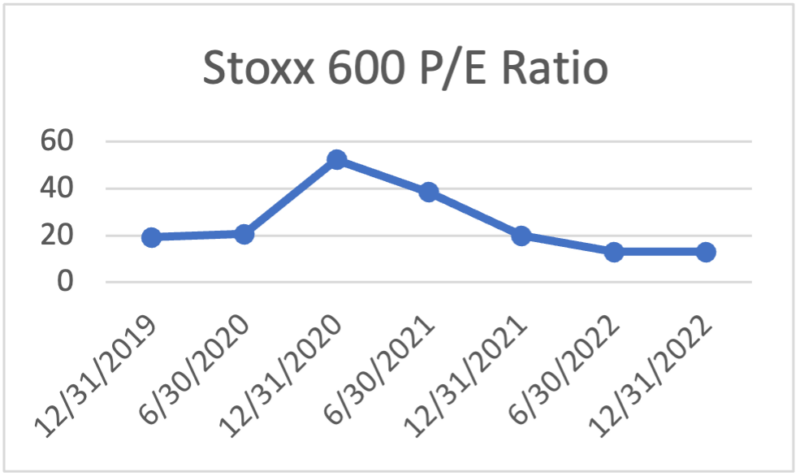
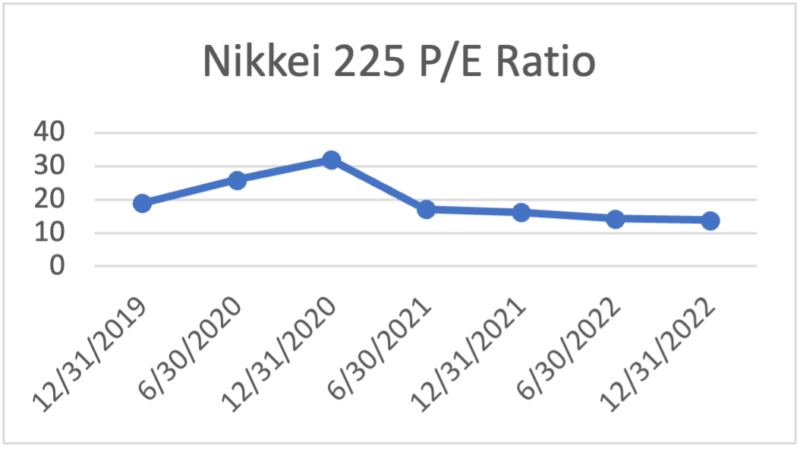
This convergence of returns is not limited to equities and three-month treasuries; it also extends to investment-grade bonds and cash yields. According to a recent survey by Bank of America, investment-grade bonds are experiencing the highest overweight positioning since 2008, with a net allocation of +10% in this space.
In conclusion, the recent market rally in the United States has resulted with matched yields among cash, bonds, and equities, which is an unprecedented occurrence in history. The decline in the earnings yield of the US500 reflects the strong performance of US markets, driven by the technology sector and semiconductors, which has not been seen in the Eurozone area to the same extent. The disparity in P/E ratios between the US500 and European indices can be attributed to differences in sector composition to some extent, however, there has been a long-standing valuation gap between US markets and the EU and UK markets which many are wondering whether this could be a reason for such gap to narrow or close, however, that is yet to be seen.
Referencing
Bloomberg Data, Bloomberg Data. “Bloomberg – Asia Pacific Stocks.” Www.bloomberg.com, Bloomberg Financial Data, 21 June 2023, www.bloomberg.com/news/articles/2023-04-18/investors-turn-most-underweight-stocks-versus-bonds-since-2009#xj4y7vzkg. Accessed 21 June 2023.
Mosolova, Daria, and Mary McDougall. “Rate Rises Erode Investors’ Incentive to Hold US Companies’ Shares.” Financial Times, 18 June 2023, www.ft.com/content/79b7775a-fe35-4591-ae4a-cc31eea1c81c. Accessed 21 June 2023.
Research, Siblis . “P/E & CAPE Ratio of Nikkei 225 & Japanese Stock Market.” Siblis Research, 20. 2023, www.siblisresearch.com/data/japan-nikkei-pe-cape/. Accessed 21 June 2023.
Research Service, MacroTrends. “S&P 500 PE Ratio – 90 Year Historical Chart.” Www.macrotrends.net, 21 June 2023, www.macrotrends.net/2577/sp-500-pe-ratio-price-to-earnings-chart.
Reddy, Sam Moore, Rohan. “Global X 1-3 Month T-Bill ETF (CLIP).” Global X ETFs, 21 June 2023, www.globalxetfs.com/introducing-the-global-x-1-3-month-t-bill-etf-clip/. Accessed 21 June 2023.
Chart of the Week: Unprecedented Concentration in Equity Markets Raises Concerns – Will History Repeat Itself?
Author: Tim Sharp
Researcher: Jack Williams
Published: June 14, 2023
The year of 2023 has been an anomaly for many reasons, perhaps the main one being the extreme concentration within equity markets, especially within recent months. Defined here as the concentration of top 10 leaders to the three-month performance of the US500, is above the 99th percentile over the past 30 years.
Shown below in figure one, you can see in light blue the weighting of the top ten leaders within the US500, and in dark blue the contribution of those top ten leaders.

Figure 1-Refinitiv Data / Barclays Research
| Stock | Weighting | YTD Performance | PE Ratio |
| Apple (AAPL) | 7.50 | +46.57% | 31.14 |
| Microsoft (MSFT) | 6.7 | +39.53% | 36.23 |
| Amazon (AMZN) | 3.1 | +47.59% | 307.09 |
| Nvidia (NVDA) | 2.6 | +186.57% | 213.19 |
| Alphabet (GOOGL) A | 2.203 | +38.95% | 27.96 |
| Tesla (TSLA) | 1.846 | +139.32% | 76.17 |
| Alphabet (GOOG) C | 1.7737 | +38.72% | 28.09 |
| Meta Platforms | 1.658 | +117.51% | 34.63 |
| Berkshire Hathaway (BRK.B) | 1.651 | +8.54% | N/A |
| United Health Group | 1.26904 | -5.27% | 22.47 |
Since the mid 1990’s there has only been two instances with comparable levels of concentration, the first being the 2000 dot com bubble, and the second being the 2020 Covid rebound, both opposites in terms of outcomes for the market.

Figure 4 – 2020 Covid Rebound (Refinitiv Data)

Figure 5 – Dot-Com Market Low (Refinitiv Data)
During the 2020 Covid Rebound, the market ripped higher by +20% while the top ten underperformed the US500 remaining flat for the first 9 months. Following this nine month period, the US500 rallied further instead being led by the top 10 stocks. 10 Leaders rallied +33% while the US500 ripped higher by 15%, highlighting the dramatic outperformance in this period by the top 10 names.
Market participants are currently weighing up which scenario, 2020 rebound or dot com era misery will prevail. With the debate amongst institutions continuing, recently several houses have been making their views known as to whether they view the latest rally as worth participating in.
Barclays equity strategists commentary has been increasing in positivity recently regarding the US main market. Within a research note issued by Barclays on the 13th of June entitled “Equity Options Not Pricing for Any Surprises”, strategists issued the firms belief the current situation is closer to that seen in the Covid rebound, with the main reasoning being the dramatic difference in valuation multiples seen in the Dot Com period compared to the current market, which although higher than where a bull market typically starts are still a long way from the lofty multiples being touted in the 2000’s period.

Figure 2 – Refinitiv / Bloomberg / Barclays Research
It is worth however noting that a bear market historically has not bottomed at multiples seen currently in these markets. The most expensive bear market low to date was the US500 following the dot-com bust, in which US500 PE’s stood at 13.5 times. The second most expensive bear marker bottom was the covid rebound in 2020 where earninsg stood at 13.5 times earnings.
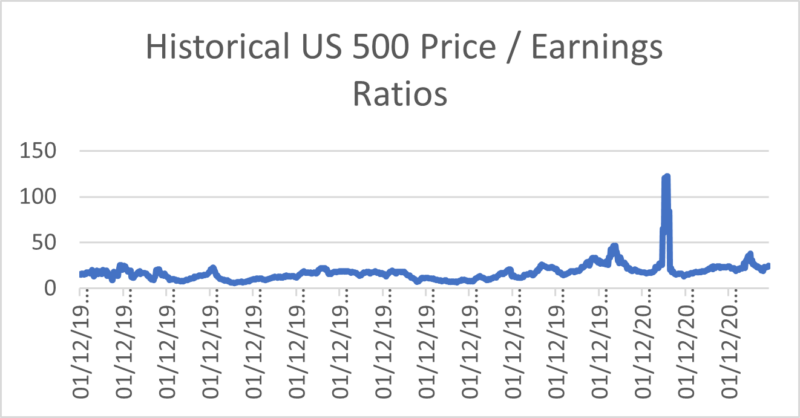
Figure 3 – Refinitiv / Hottinger Investment Management
Morgan Stanley, on the other hand, are much more bearish in their forecast. With the US500 rally now crossing the 20% threshold, many are declaring the bear market officially over. Morgan Stanley are not in this camp, quite the opposite infact. M.S are predicting a V shaped earnings recession/recovery within their forecasts.
Over 70% of the US500’s industry groups grew forward earnings expectations by 20% above pre covid levels. Morgan Stanley’s forecast of earnings stand well below current consensus. Even being so far below consensus would still put their figures 10% above the long term earnings trend line.

Figure 6 – M.S Earning Model Suggest Earning Recession Is Not Over (FactSet / Morgan Stanley)
While their forecast was lower than consensus even 6 months ago, the spread between MS and consensus has widened further while the street and buy side have raised their consensus for earnings over recent months.

Figure 7 – Spread Between Morgan Stanley Model & Consensus Rarely Been Wider (FactSet / Morgan Stanley)
Rather than looking at similar rallies or period of concentration, M.S are looking at the variables that led us to our current situation and when similar variables such as Fed hiking cycles, sticky inflation and build up of savings occurred in the past.

Figure 8 – M.S Base Case EPS Estimate Still Above Long-Term Trend (FactSet / Morgan Stanley)
Perhaps the most notable period, and which Morgan Stanley have chosen to focus on is the post WWII period. This was similar in a way where excess savings were built up and unleashed into the economy during a supply constrained environment, where inflation surges as a result.
In this case asset prices surged to prior cycle highs at a historically rapid pace. The boom in inflation and earnings lef to the Fed tightening at the fastest rate in 40 years… Sound familiar?
The boom and fed reaction caught many investors off guard, with M.S expecting many to be surprised once again by the depth of their forecasted earninings recession with the sharp V shaped recovery they forecast in 2024.
Referencing:
Research, B., Gupta, A., Pascale, S., Kang, V. and Dass, R. (2023). “Equity options not priced for any surprises ahead of heavy macro week” .
Barclays Research, Barclays Research / Barclays Live: Barclays Research , pp.1–7.
www.macrotrends.net. (n.d.). S&P 500 PE Ratio – 90 Year Historical Chart. [online] Available at: https://www.macrotrends.net/2577/sp-500-pe-ratio-price-to-earnings-chart.
Ward, S. (2022). Why Stock Multiples Say the Market Could Continue to Drop. [online] Morningstar, Inc. Available at: https://www.morningstar.com/markets/why-stock-multiples-say-market-could-continue-drop.
Slickcharts (n.d.). S&P 500 Companies – S&P 500 Index Components by Market Cap. [online] www.slickcharts.com. Available at: https://www.slickcharts.com/sp500.
Wilson, M.J., Pauker, A.B., Weaver CFA, M.M., Ding PHD, D. and Lentini, N. (2023). Weekly Warm-Up: The Bear Is Still Alive Based on Our Boom/Bust Framework. Morgan Stanley Research: Morgan Stanley Research.
Statista. (2023). Europe: PE multiples technology & telecommunications 2022. [online] Available at: https://www.statista.com/statistics/1028379/price-earnings-in-the-technology-and-telecommunications-sector-in-europe/.
May Investment Review: Dancing on the Ceiling
by Haith Nori
May saw a mixed performance across global markets. In equity markets across Europe, including the UK there was a slight decline in overall value. However, US technology stocks continued to increase, as did Japanese Equities. Elsewhere in the US equity market performance was more mixed. Yields increased on both UK 10-year Gilts and US 10-year Treasuries. The US Debt ceiling has been a key focus over the course of the month, with the House of Representatives finally passing the bill at the end of May. The US Dollar, after a weak start to the year, regained value over the month of May. Tayyip Erdogan has now been elected for 5 more years as the President of Turkey, having already been in power for 20 years. The G7 Meeting also took place in Japan where global leaders met face to face and Ukraine’s President Mr. Zelensky continued to request support from other developed countries around the world.
On 3rd May 2023, the US Federal Reserve made the decision to increase interest rates by 0.25% from 5.00% to 5.25%, marking the highest level of interest rates reached in the past 16 years. On 5th May the European Central Bank also raised interest rates by 0.25% to 3.25%, this being the seventh straight hike in a row and with the previous three rate hikes all being 0.50%. Following suit, on 11th May the Bank of England also made the decision to increase interest rates by 0.25% to 4.5%, this being the 12th time in a row that the Bank of England has increased interest rates. The UK bank rate is now the highest it has been since 2008. The next meetings for the Federal Reserve, the European Central Bank and the Bank of England will be in June 2023.
On 10th May, US CPI data was released for the last 12 months ending in April. Headline inflation came in at 4.9%, 0.1% lower than that of March of 5%. Previous figures were 6.0% in February, 6.4% in January, 6.5% in December and 7.3% in November, highlighting inflation’s gradual decline since June 2022 (9.1%). On 17th May, Eurozone CPI data was released for the last 12 months ending in April of 7%, slightly up from March’s 6.9%. On Wednesday 24th May, UK CPI data was released for the last 12 months ending in April of 8.7% compared to 10.1% for March, 10.4% in February, 10.1% in January. This is down from its peak of 11.1% in October. Whilst this did not meet consensus expectations of 8.2%, it is the largest reduction in CPI data since the pandemic and has dropped below 10% for the first time in 8 months.
Ukraine’s President Volodymyr Zelensky has been requesting support across Europe before arriving in the UK on Monday 15th May. The UK Prime Minister Rishi Sunak said ‘Britain would provide Ukraine with hundreds of air defence missiles and further unmanned ariel systems, including new long-range attack drones with a range of more than 200km’[i]. The delivery is expected in the following months and will be combined with Britain beginning training of Ukrainian pilots this summer. In addition to the UK, Germany has vowed to send up to $3 Billion worth of arms and France pledged to train and equip Ukrainian battalions with dozens of armoured vehicles.
The G7 meeting was held between 19-21st May in Hiroshima, Japan where members stood united on various global issues including support for Ukraine, nuclear disarmament, China, clean energy economies, economic security, and climate change. US President Joe Biden has pledged $375 million in a military aid package with other G7 leaders pledging their continued support. Concerns over China were raised, including Beijing’s military activities against Taiwan and its use of economic coercion for its political gains. The G7 heads expressed their desire to work with China constructively but the existing issues needed to be addressed. However, ‘Beijing’s foreign ministry said it firmly opposed the statement by the G7’ and ‘said it had summoned Japan’s ambassador to China in a pointed protest to the summit host’[ii] highlighting the intensity of frustration and China’s newspaper the Global Times dubbing the G7 summit an “anti-China workshop”.
The US debt ceiling, which is the limit set by the US Congress on the amount of Government debt that can be accrued, has been in critical negotiations in May. Ever since the legislative cap was created in 1917, a majority vote is required by both the House of Representatives and the Senate. The vote raises the upper limit of how much the government can borrow. Since 1960, the debt ceiling has been raised 78 times but never reduced. The Democrats want the debt ceiling to be raised but the Republican leaders wish for spending cuts to be agreed first. President Biden is arguing that issues regarding government spending are separate from the issue of raising the debt ceiling. Currently, the nation’s debt ceiling is $31.4 trillion and a deal is needed to be struck as Treasury officials estimated that if they were to continue spending at the current rate the US could run out of money by Monday 5th June. Finally, on Wednesday 31st May, The US House of Representatives passed a bill suspending the debt ceiling which will need to be signed by Joe Biden in order to be put into law. ‘The legislation suspends – in essence, temporarily removes – the federal government’s borrowing limit through Jan. 1, 2025’[iii] setting aside the issue until after the next US Presidential Election in November 2024.
Overall, May has seen mixed performance within asset classes. Brent Crude, after starting the month at levels of c.$80 per barrel, decreased over the course of the month ending at c.$73 per barrel. UK 10-year Bond yields and US 10-year treasury yields both continued to increase. Gold fell in value whilst the US Dollar rose.
[i] https://www.reuters.com/world/ukraines-zelenskiy-meet-british-pm-sunak-2023-05-15/
[ii] https://www.reuters.com/world/china/china-summons-japanese-ambassador-over-actions-g7-2023-05-22/
[iii] https://www.reuters.com/world/us/us-debt-ceiling-bill-faces-narrow-path-passage-house-2023-05-31/
Chart of the Week: Erdogan Elected Causes Financial Volatility, Will Anything Change This Time?
Author: Tim Sharp
Researcher: Jack Williams
Published: June 1, 2023
After Turkish President Tayyip Erdogan’s re-election, Turkey’s financial markets once again experienced turbulence, as the Turkish Lira reached an all-time low against the US dollar, and the country’s sovereign bonds depreciated in value. Erdogan, who has been in office since August 2014, secured another five-year term, defeating opposition leader Kemal Kilicdaroglu, a Turkish economist, retired civil servant, and social democratic politician who was widely regarded as someone capable of addressing the problems that have arisen during Erdogan’s tenure. Since 2016, Turkey has faced strained relations with most European nations, a decline in media freedom, and, most significantly, an increase in the money supply during periods of high inflation, leading to further inflationary pressures.

Figure 1 – Turkish Inflation Rate (Statista)
Remarkably, Turkey’s inflation rate over the past 12 months has surpassed a 24-year high, soaring to over 85%. These price surges can be attributed to Erdogan’s unorthodox monetary policy, which contradicts the approach taken by other central banks and countries during this period of high inflation. Rather than raising interest rates, as most would expect, Erdogan has pursued a strategy of lowering rates, resulting in spiralling inflation that has negatively impacted the population. Unsurprisingly, this issue featured prominently in the election campaigns of both major parties in the recent election.
Investors have expressed concerns about this matter and have contemplated whether Erdogan might consider revising his monetary policy to restore financial prudence in the country. In recent weeks, an internal party team has hinted at the possibility of such a policy shift.
This renewed enthusiasm has sparked a rally in Turkish equities, particularly in the banking sector. Notably, the broader Turkish Index (BIST) has surged by 11.84%, while the banking-focused Turkish BIST BANKA index has experienced a remarkable rally of 14.94% in the past five trading days alone. Although Turkish Credit Default Swaps (CDS) have only marginally retreated from their elevated levels, decreasing from 624 to 622, the cost to insure against defaults has significantly risen since the beginning of the year. CDS swaps started the year at a rate of 513, representing an increase of 21.2% to their current levels.

Figure 2 – Turkish BIST Index (RefinitivData)

Figure 3 – Turkish BIST BANKA Index (RefinitvData)
Turkish investors undoubtedly hope for further declines in CDS rates as Erdogan announces his new cabinet, in the expectation that some positions will be filled by candidates who favour a more open-market approach. This would pave the way for the necessary changes to Turkey’s detrimental monetary policy, which both the country and international investors aspire to witness. Presently, Turkish 10-year bonds offer a yield of 9.705% and have performed poorly compared to other emerging market (EM) debt instruments, with a decline of -5.8% as opposed to the -1.6% decrease observed in the broader EM dollar bond space.

Figure 4 – Turkey CDS (WorldGovBond)
Sources:
Al Arabiya English. (2023). Turkey sovereign dollar bonds rise as markets await Erdogan’s economic team. [online] Available at: https://english.alarabiya.net/business/economy/2023/05/30/Turkey-sovereign-dollar-bonds-rise-as-markets-await-Erdogan-s-economic-team [Accessed 31 May 2023].
Karakaya, K. (2023). Turkish Lira Sinks, Stocks Gain as Investors Bet on Policy Shift. Bloomberg.com. [online] 30 May. Available at: https://www.bloomberg.com/news/articles/2023-05-30/turkish-lira-sinks-stocks-gain-as-investors-bet-on-policy-shift.
Parsons, A. (2023). As Kilicdaroglu takes on Erdogan – here’s why Turkey’s election may well be the most important in the world this year. [online] Sky News. Available at: https://news.sky.com/story/as-kilicdaroglu-takes-on-erdogan-heres-why-turkeys-election-may-well-be-the-most-important-in-the-world-this-year-12879032.
Statista. (n.d.). Turkey monthly inflation rate 2022. [online] Available at: https://www.statista.com/statistics/895080/turkey-inflation-rate/.
TradingEconomics (n.d.). Turkey Government Bond 10y – 2022 Data – 2010-2021 Historical – 2023 Forecast – Quote. [online] tradingeconomics.com. Available at: https://tradingeconomics.com/turkey/government-bond-yield.
Charts/Data – RefinitivData / Hottinger Investment Management / YCharts
Chart of the Week: 2023’s Debt Ceiling Issue Seems Eerily Similar to 2011’s
Author: Tim Sharp
Researcher: Jack Williams
Published: May 25, 2023
The 2011 debt ceiling issue was a significant event that unfolded in the United States, casting a shadow of uncertainty over the country’s financial stability. The dispute, primarily between the Obama administration and the Republican-controlled Congress, revolved around raising the federal debt ceiling to avoid defaulting on the nation’s financial obligations.
The debt ceiling is a statutory limit set by the US Congress on the amount of national debt the government can accumulate, which has been a major story in recent weeks as the US default probability rises, and the country nears their resolution deadline.
In 2011, the United States approached its debt ceiling of $14.3 trillion, leading to a heated political debate. Republicans demanded significant spending cuts and fiscal reforms in exchange for raising the ceiling, while the Obama administration argued for a “clean” increase without any attached conditions.
As we near the 2023 ‘X’ date of the 15th of June 23’ (the date interest payments on U.S debt are scheduled to be made, many institutions such as J.P Morgan, rather than looking forwards are looking backwards to 2011 to gain an idea of how the market might react should the U.S not come to a resolution in time.
Whilst many of the same names (JPM etc.) are cautiously optimistic that discussions between Biden and speaker McCarthy will produce at least a partial deal to either raise or suspend the debt ceiling, as we near the ‘X date’ the risk of default rises dramatically.
The chart below shows the probability of the U.S defaulting, and how the risk of default grows as the ‘X date’ nears. The blue line below shows the probability of default in 2011, as the U.S neared their X date a sharp uptick in risk of default appeared, rising to almost 6%.
The partial grey line follows the risk of a U.S default this year (2023) which has seen a sharp rise recently, similar to moves seen in 2011.

Figure 1 – J.P. Morgan Equity Macro Research, Bloomberg Finance L.P

Figure 2 – Bloomberg Data
Figure 2 below shows short term 1-month T-Bill yields, which as of recent have spiked, suggesting increasing default concerns, a stark contrast to the rallies seen amidst US indices in recent weeks.
In times such as these where volatility is expected, one might expect to see flows into treasuries as investors look to take some risk off the table, however T-Bill have surprisingly traded in the opposite direction, now trading at yields in excess of those seen amidst the 08’ financial crisis.
In 2011, prolonged and contentious negotiations over the debt ceiling caused uncertainty to flood into financial markets, particularly within the U.S as investors worries about the prospect of a default. This led to increased volatility and heightened risk which lasted for nearly three trading months.
In the weeks leading up to the 2011 August 2nd deadline the market experienced significant swings. Throughout July 11’ all major US indices (DJIA, US500 and Nasdaq) witnessed substantial declines. The DJIA for example saw several days of triple digit losses, with the index shedding over two thousand points through a two-week period.


Figure 3 – J.P. Morgan / Bloomberg
During this time, the US 500 index declined by 17% with the brunt of the beating being felt by materials, financials, and energy, while defensive strategies excluding real estate outperformed.
Furthermore, to amplify market turmoil, ratings agency Standard and Poor’s downgraded the US sovereign credit rating from AAA to AA+, marking the first time in history the U.S lost its top tier credit rating.
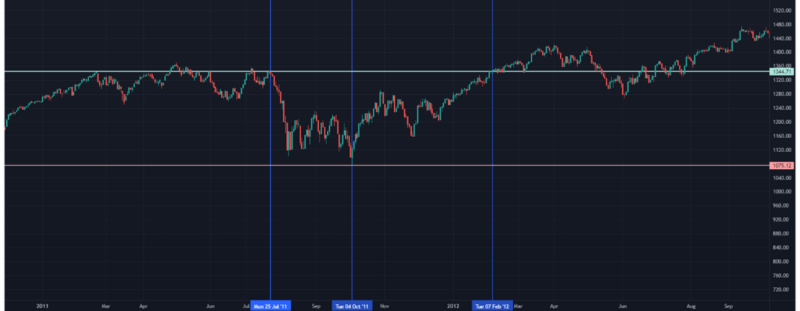
Figure 4 – SP500 (2011) TradingView
While there are clear differences between the 2011 debt debacle and the current issue, perhaps the largest being the Rate of Inflation and Fed Funds Rate (both of which were dramatically lower in 2011 than today) many lessons have been learned regarding why negotiations must be conducted and concluded swiftly. That being said, one cannot ignore the risk however small of a US default and its potential impact on markets.

Figure 5 – Bloomberg Data
The U.S president Joe Biden has cancelled a planned visit to Australia and Papua New Guinea to focus on debt limit talks, with speaker McCarthy commenting that talks were productive in nature. It is true that the US has never defaulted on its payments before and the debt ceiling has been raised 78 times since 1960 under both republican and democrat presidents, although ex-president Trump is calling for a default as his preferred resolution.
On 26th April Republicans passed a bill in the house that would raise the debt ceiling by $1.5Tr but mandated $4.8Tr in spending cuts over a decade, although democrats have so far refused to negotiate spending cuts over the debt ceiling talks.
Negotiations are expected to resume Wednesday 24th with Republicans looking for some kind of guarantee on spending/budget caps and investors hoping for news regarding some sort of resolution.
Sources:
Asset Management , J.P.M. (2023). How Does the Debt Ceiling Progress From Here? | J.P. Morgan. [online] www.jpmorgan.com. Available at: https://www.jpmorgan.com/wealth-management/wealth-partners/insights/how-does-the-debt-ceiling-progress-from-here#:~:text=With%201Y%20CDS%20at%20a.
Authers, J. (2023). On X+1 Day, We Won’t Be Going Back to Normal. com. [online] 24 May. Available at: https://www.bloomberg.com/opinion/articles/2023-05-24/debt-deal-before-x-1-day-the-us-crisis-will-have-already-begun?leadSource=uverify%20wall.
Aratani, L. (2023). What is the US debt ceiling and what will happen if it is not raised? The Guardian. [online] 17 May. Available at: http://www.theguardian.com/business/2023/may/16/what-is-debt-ceiling-limit-explainer.
BGR Group (2021). History of Debt Limit and Why It Matters | BGR Group. [online] BGR Group. Available at: https://bgrdc.com/history-of-debt-limit-and-why-it-matters/.
Palumbo, A. (2023). Stock Market Today: Dow Drops, Premarket Movers, Debt Ceiling Talks, Fed Minutes, Bitcoin Falls, Nvidia Earnings, China Covid-19. [online] www.barrons.com. Available at: https://www.barrons.com/livecoverage/stock-market-today-052423?mod=article_inline.
P. Morgan (n.d.). Debt ceiling drama: What you need to know. [online] www.jpmorgan.com. Available at: https://www.jpmorgan.com/wealth-management/wealth-partners/insights/debt-ceiling-drama-what-you-need-to-know#:~:text=Today%2C%20that%20limit%20stands%20at.
Chart of the Week: The Gold Vs Copper Conundrum
Author: Tim Sharp
Researcher: Jack Williams
Published: May 18, 2023
In this week’s Chart of the Week, we examine the recent performance disparity between copper and gold, two key commodities, within the context of the current global economic environment. While the overall Goldman Sachs Commodity Index (GSCI) has experienced losses of approximately 30% over the past year, certain commodities within the index have demonstrated strong returns, fuelled by the prevailing high inflation and uncertainty. This study aims to elucidate the drivers behind the contrasting performance of copper and gold by delving into the factors that influence their respective prices.

Copper’s Underperformance
Despite the positive economic growth forecasts, particularly those for China, which exceed 5% in terms of economic expansion, copper’s performance has surprised many investors. Given copper’s extensive use in construction, electrical equipment, wiring, and manufacturing, its price movements are closely tied to global economic growth and investor sentiment. However, the present climate of heightened global uncertainty surrounding economic growth in the US, Eurozone, and UK does not bode well for copper. As a result, the anticipated rise in copper usage, which would tip the supply/demand balance in favour of investors, has not materialized. Consequently, copper has lagged gold in terms of returns.

Copper vs. Gold: The Role of Cyclical Stocks
The performance of copper and gold is intricately linked to cyclical stocks, exhibiting a correlation of 76%. Cyclical industries, such as manufacturing, construction, automotive, heavy machinery, and infrastructure development, are heavily influenced by the overall economic cycle. During periods of economic prosperity, these industries thrive, while economic downturns pose challenges for them. Copper, being closely associated with economic growth, is often used as a leading indicator of economic health. An increase in copper prices and demand signals optimism regarding future economic growth. Conversely, gold’s performance is driven by factors such as central bank policies, inflation and currency fluctuations (particularly in the context of a weak dollar), economic and political instability, and investor sentiment.
Gold’s Strengths
Gold, traditionally regarded as an inflation and war hedge amongst investors, has regained its appeal as such due to recent developments. Central banks, grappling with historically high and persistently sticky inflation, have raised interest rates to curb rising prices. Additionally, ongoing geopolitical tensions, including the war in Ukraine, escalating China-Taiwan tensions, and deteriorating relations with Western nations, have heightened economic and political instability to levels not witnessed in recent times. These factors have significantly favoured gold investors, as the precious metal is perceived as a ‘safe haven’ in times of uncertainty.
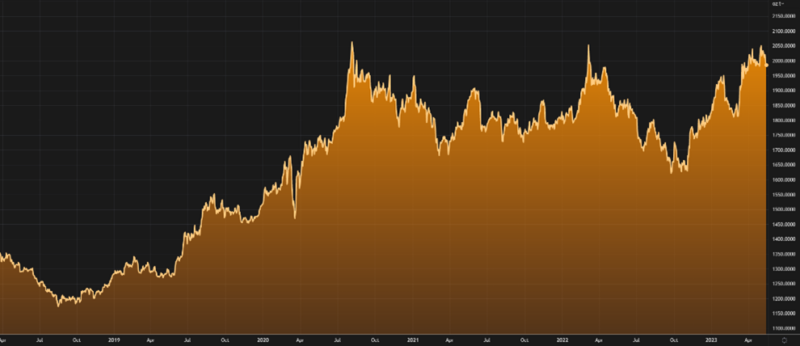
Summary
In brief conclusion, the substantial underperformance of copper compared to gold can be attributed to the global economic climate and the nature of the commodities themselves. Copper’s price movements are closely tied to economic growth and investor sentiment, making it susceptible to the prevailing uncertainties. On the other hand, gold’s performance is driven by a range of factors, including central bank policies, inflation, geopolitical tensions, and investor sentiment. Given the present economic landscape characterized by uncertainty, high inflation, and geopolitical risks, gold has outperformed copper and lived up to its status as an inflation and war hedge, at least for the time being. These findings highlight the importance of analysing the drivers behind commodity price movements and considering the broader economic and geopolitical context when making investment decisions.
Sources:
S&P GSCI Total Return Performance & Stats (ycharts.com)
https://ycharts.com/indicators/gold_price_london
RefinitvData/Hottinger (ABRDN Physical Gold x WisdomTree Copper x Wisdomtree Silver x Crude Spot Price)
RefinitivData/Hottinger Gold Spot Price – 5yr
S&P GSCI Total Return Performance & Stats (ycharts.com)
https://www.bullionbypost.co.uk/price-ratio/gold/silver/10year/
https://www.xe.com/currencyconverter/convert/?Amount=1&From=USD&To=GBP
Chart of the Week: US Closes In On Debt Ceiling, Potential for Default Rises
Author: Tim Sharp
Researcher: Jack Williams
Published: May 16, 2023
As anxiety spreads among investors, the cost of insuring against a possible U.S. credit default has surged to its highest level in more than ten years, surpassing levels observed in early 2009. This surge is a result of the United States coming closer to the brink of a potential default or breach of its debt ceiling.
Shown on the below chart, the United States has reached the level of its debt ceiling following a rapid rise in borrowing from 2017, partially worsened by the pandemic and knock on measures the country had to take to keep the economy alive such as their mass Stimulus Payments scheme.
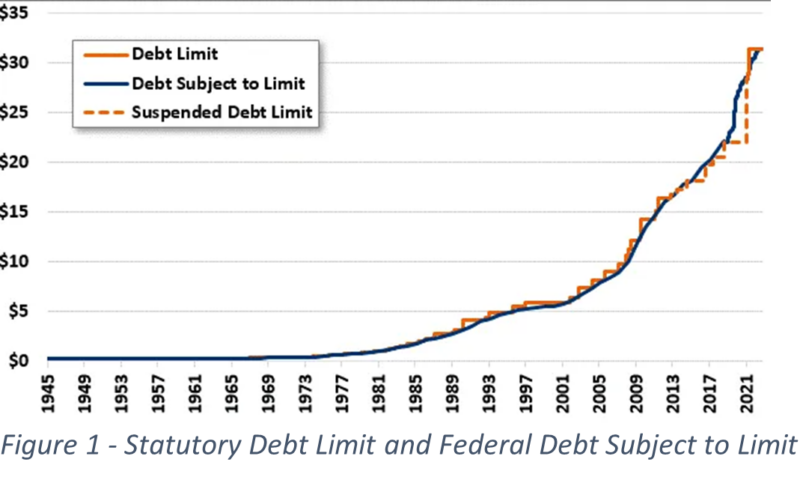
Yesterday, US Sovereign CDS (Credit Default Swaps) rose again to 74 basis points according to Bloomberg Global Market Data, up from 73 points on the previous day’s close (+1.34%), and the highest level traded since March 2009.
A credit default occurs when a borrower is unable to meet its debt obligations, causing a default on its loans. In the case of the United States, a default would mean that the country would be unable to repay its debt, which would have severe consequences for the global financial system. Given that the United States is one of the largest borrowers in the world, a default could potentially trigger a major crisis, and could even lead to a sharp increase in borrowing costs, and a potential drop in the value of the U.S. dollar.
In order to protect themselves from the risks of a potential default, investors buy credit default swaps (CDS), which are financial instruments that act like insurance policies against default. A CDS pays out in the event of a default, providing investors with compensation for the losses they may incur.
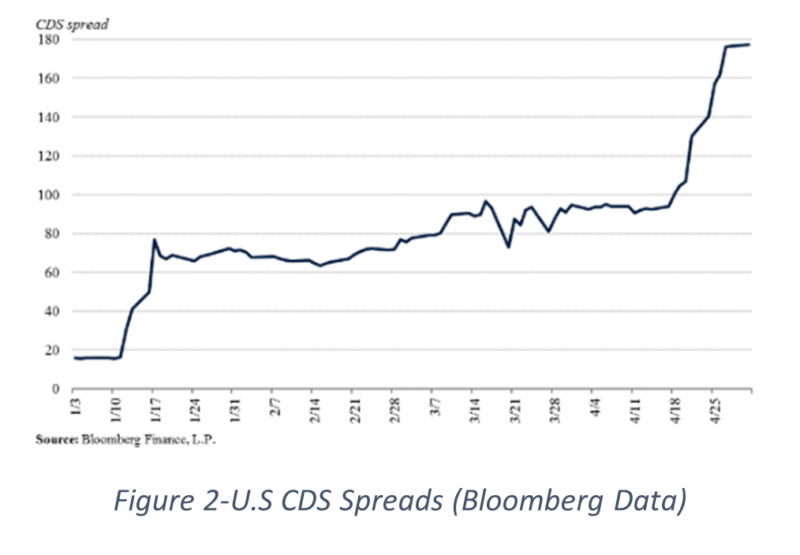
The surge in the cost of CDS indicates that investors are becoming increasingly worried about the United States’ ability to meet its debt obligations. The cost of insuring against a potential default has risen significantly, suggesting that investors believe that the likelihood of a default is increasing, however it is worth noting that the overall probability of a US default is less than 6% over the next 5 years.
Substantial evidence of market stress linked to the tensions surrounding the debt ceiling have already begun to appear. Such has been seen recently by the significant increase in yields on Treasury bills that are set to mature around the X-date (Potential Default Date), resulting in higher borrowing costs for the government and consequently, for taxpayers as well. Figure 2, depicted below, clearly shows this trend. Since mid-April, there has been a near 1 percentage point increase in yields on short-term Treasury bills, which is nearly a 20% move from where yields previously stood. US Treasury Secretary Janet Yellen has been trying to raise the alarm, she says the potential default could happen as soon as June 1st.

When asked to speak to the potential outcomes of a default on US debt, the White House points to the written piece on their default which includes a study on the risks of a protracted default. A simulation ran by the CEA showed an immediate, sharp recession to the magnitude not seen since the great recession (2007-2009). In 2023 Q3, the first full quarter following the simulated debt ceiling breach, the simulation showed a 45% drawdown in the stock market, while consumer and business confidence takes a substantial hit. Unemployment was modelled to increase by 5 percentage points as consumption cuts take place.
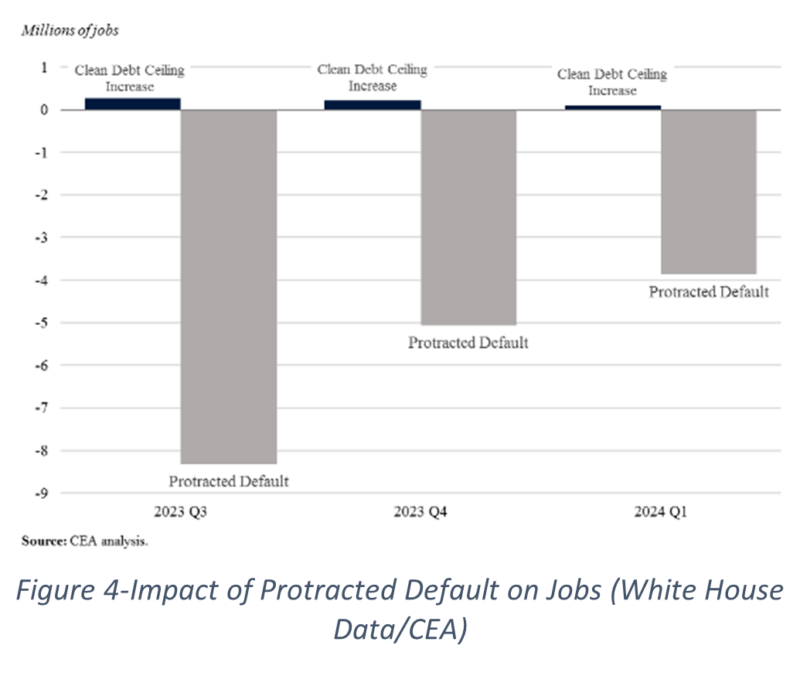
Moody’s recently undertook a similar study using their own model, which predicted under a clean debt ceiling breach job growth continues northbound adding 900,000 jobs. Although under a protracted default situation, the modelled job losses amount to almost 8 million, which would be even further unemployment than The White House is forecasting within their own.
https://www.whitehouse.gov/wp-content/uploads/2023/05/DL-Figure-1.3.png
https://www.whitehouse.gov/wp-content/uploads/2023/05/Debt-Limit-Blog_Figure2.png
Figure 1 – https://www.crfb.org/papers/qa-everything-you-should-know-about-debt-ceiling
Figure 2 – https://www.whitehouse.gov/cea/written-materials/2023/05/03/debt-ceiling-scenarios/#_ftn1
Figure 3 – https://www.whitehouse.gov/wp-content/uploads/2023/05/DL-Figure-1.3.png
Figure 4 – https://www.whitehouse.gov/wp-content/uploads/2023/05/Debt-Limit-Blog_Figure3.gif
Datapoints/charting – Bloomberg Global Market Data / Refintiv Data
April Investment Review: Light Relief
by Haith Nori
April delivered some light relief following the volatility witnessed over the first quarter of the year. There has been a flurry of Merger & Acquisition deals within the financial industry, including Rathbones buying the UK arm of Investec and Deutsche Bank agreeing to buy London based investment bank Numis. JP Morgan Chase have had their offer accepted on First Republic Bank after being in a bidding war in the final week of April following the Federal Deposit Insurance Corporation (FDIC) reaching out to big banks in the US.
On Tuesday 4th April, the ‘US unveiled $2.6 billion worth of military assistance that includes three air surveillance radars, anti-tank rockets and fuel trucks, the Pentagon announced’[i]. Countries are still providing support to Ukraine as the war has still not reached a resolution. In the UK, Jeremy Hunt, Chancellor of the Exchequer, confirmed that an additional $500 million in guaranteed loans would be provided by the UK on 13th April.
On 4th April, Rathbones agreed to buy the UK Wealth arm of Investec in an ‘all-share deal that values the unit at 839 million pounds ($1.04 billion)’ [ii]. If the deal goes to plan, a very large wealth manager will be created with approximately 100 billion in assets under management. On the flip side, Investec will own 41.25% stake in the combined firm. The deal is still subject to the necessary regulatory approvals and is estimated to be completed in the final quarter of 2023.
On Friday 28th April, Germany based Deutsche Bank announced that it ‘had agreed to buy Numis Corp (NUM.L), a London-based boutique investment bank, for about 410 million pounds ($511 million) as the German company continues to deepen its links with British corporate clients’[iii]. This is a cash consideration deal valuing Numis at 350 pence per share and is Deutsche Bank’s largest acquisition in more than a decade. The deal will provide Deutsche Bank with strong links to the UK and Ireland which it intends to combine its existing corporate finance business in these areas with Numis, a leading UK corporate broking and advisory house. The deal is again expected to be completed during the final quarter of 2023 subject to regulatory approval.
First Republic Bank, the third bank to fail since March after Silicon Valley Bank and Signature Bank, saw several bidders trying to capitalise on the bank’s demise. The bank had been seized by regulators and the Federal Deposit Insurance Corporation (FDIC) was subsequently appointed the bank’s receiver. In the last week of April, the FDIC had been reaching out to other big banks in the US to gauge interest in acquiring its assets. On Sunday 30th April, the race had reduced to just four competitors after the FDIC informed potential investors to input their final bids by a deadline of noon. JP Morgan Chase were one of the bidders and had dedicated the task of due diligence on First Republic Bank to over 800 employees. The deal was later accepted by the FDIC and announced in the early hours of Monday morning, where ‘JP Morgan will pay $10.6 billion to the U.S. Federal Deposit Insurance Corp (FDIC) as part of the deal to take control of most of the San-Francisco-based bank’s assets and get access to First Republic’s coveted wealthy client base’[iv]. US President Joe Biden praised the deal, announcing his evaluation that JP Morgan was helping make the US banking system more secure. The deal has received all the necessary regulatory approvals and has since closed.
On 12th April US CPI data was released for the 12 months ending in March of 5%, down from 6.0% in February, 6.4% in January, 6.5% in December 2022 and 7.3% in November 2022, continuing its gradual decline since June of last year at 9.1%! This is the largest decrease seen for a while, and lower than expectations which shows some positivity. On 19th April UK CPI data released was 10.1% for the 12 months ending in March, compared to 10.4% in February and 10.1% in January. A decline has been seen but the headline rate remains above double digits and is now back to the levels achieved at the start of the year. There has been a 1% decrease since October’s 11.1% and there is still a long way to go if the Bank of England is to achieve their overall inflation target of 2%. The next meetings for the Federal Reserve, Bank of England and the European Central Bank will be held at the beginning of May where they will once again address the decision of whether to change interest rates.
In other asset classes the UK 10-year Bond yield started the month at c.3.429%, ending at c.3.718% showing an increase in yields, returning to levels last seen at the end of February and beginning of March. On the other hand, the US 10-year Treasury yield started the month at c.3.432% and ended at c.3.452% showing little gain (and unlike the UK 10-year bond has not returned to its levels at the beginning of March). The price of Gold, which increased in March, saw little movement during April remaining at high levels. GBP continued to gradually strengthen against the US Dollar over the course of April ending the month at its highest level since the beginning of the year. Global equity markets closed marginally higher in April. In the UK house prices have increased by 0.5% ‘following seven consecutive falls going back to last September’[v].
Overall, April has seen less volatility than has occurred since the beginning of the year within asset classes. Brent Crude, after starting the month back at levels of c.$85 per barrel, increased slightly over the course of April and subsequently fell, ending the month at c.$80 per barrel. UK 10-year Bond yields were higher than US 10-year treasury yields.
[i] https://www.reuters.com/world/us-pledges-another-26-billion-weapons-aid-kyiv-statement-2023-04-04/
[ii] https://www.reuters.com/markets/deals/rathbones-investecs-uk-wealth-arm-merge-deal-valued-839-mln-stg-2023-04-04/
[iii] https://www.reuters.com/markets/deals/deutsche-bank-buy-institutional-stockbroker-numis-511-mln-2023-04-28/
[iv] https://www.reuters.com/business/finance/california-financial-regulator-takes-possession-first-republic-bank-2023-05-01/
[v] UK house prices rise after seven months of falls; factory downturn deepens; eurozone inflation rises to 7% – business live (theguardian.com)
Chart of the Week: Lithium’s Lacklustre 2023 Performance
Author: Tim Sharp
Researcher: Jack Williams
Published: April 27, 2023
Demand for the mineral and the products it can produce has arguably never been higher, however the raw spot price of Lithium Carbonate, the preferred form of lithium for uses such as EV Batteries and grid storage has plummeted in recent months, losing nearly two thirds of its value.

As the global energy landscape evolves and the demand for renewable energy solutions and electric vehicles increases, Lithium has emerged as a key part of the energy transition towards sustainability. Amongst its forms, Lithium with its high energy density has gained significant attention in recent years as an opportunity for investors wishing to play the green transition within their portfolios. Lithium Carbonate, the lithium form of choice for EV battery builders and energy storage systems due to its purity and being amongst the highest of energy densities within the metals, has been watched closely in recent months as prices retreat from it’s all time high of 597,500 CNY/Tonne to below 175,000 CNY.
Recently Bloomberg released a study forecasting the Global Lithium Supply and Demand through to 2030, in which they predicted Lithium Demand to more than triple by the end of the decade with government programmes phasing out the production of traditional ICE (Internal Combustion Engine) based cars and transport, along with an increased prioritisation towards the storage of the energy generated from renewable sources such as wind farms that has been seen in recent years. Other bullish drivers considered within the Bloomberg study included enhanced customer adoption and interest around lithium-based transport, increased milage/battery pack sizes, increased lithium content in chemistries and real-world energy cell densities increasing. All of which would be positive for lithium in the longer term, or one would think so.

For Lithium investors, recent months have been disheartening to say the least, while EV bulls have rejoiced at the prospect of the lower costings for the most expensive part of the car to produce going forward. For Longer range EV’s, as much as $20,000 or £16,099 of the price tag of an EV comes from the cost of the battery.
Many investors are wondering with such a strong long-term story, why has Lithium has been hit so hard in recent months?
On the demand side, this can be explained by a less bullish sentiment around EV’s in China as a decade long EV subsidy programme winds down in addition to the extended Lunar New Year celebrations which eroded the sales of new cars at the turn of the year.
Lithium Analysts such as Fastmarket’s Jordan Roberts side with the theory of markets waiting to see the impact from lower consumer subsidies and consumer confidence data, which is currently tied to the country’s property crisis. By subsidising EV’s to price parity with conventional ICE cars, the country experienced a huge swathe of growth in its EV market, most recently at a rate of 90% in 2022. Dutch ING Groep formed a similar thesis in late February when they said “the fiscal burden has risen, and the government may not want to spend on subsidies to boost consumption when the economy is recovering. After the fiscal driven spike over the past few years, EV sales will slow.”
In Mid-February, the worlds largest Lithium-Ion battery manufacturer CATL (Contemporary Amperex Technology Co., Limited) had started offering discounts on batteries sold to Chinese EV companies such as Nio and Xpeng showing the downturn in spot prices for the essential minerals involved in battery production. CATL held around 37% market share globally for EV makers.
While demand for lithium is somewhat impacted, many point to the supply side of lithium as being the main contributor to falling prices this year. Production and exploration of Lithium have increased over recent years, with miners motivated by high spot prices and limited supply levels, however this according to many institutions could be set to change as waves of fresh supply come online from facilities in China, Australia and Chile. Bank of America, JP Morgan and Morgan Stanley all forecast production increases of between 22% and 42% in 2023 alone. New supply is coming online at a roaring pace, while demand appears to remain relatively strong given its long-term prospects, supply surges and downstream overcapacity could bring lithium prices down further in the medium term.
Recent announcements in March have continued to drive down lithium prices as supply is unveiled in more jurisdictions globally, such as the first lithium deposit to be discovered in Iran’s mountain province of Hamedan, believing to hold over 9 million tonnes of lithium, equitable to around 10% of the world’s total proven deposits. Discoveries of this size cause investors to reassess the total amount of lithium out in the world, and the price they are willing to pay for it. Scarcity drives prices, while abundances drive prices down in the same way as seen most other metals and commodities.
 The question in many investors are pondering is with such a structural change emerging with Lithium and it’s strong future prospects, will these pockets of uncovered supply really put a dampening on the long term spot price or has the negativity amongst investors perhaps been overdone, with more use cases coming forward, can the scales of supply and demand equalise once again for Lithium as EV’s, Battery Storage and green energy increase in popularity and availability.
The question in many investors are pondering is with such a structural change emerging with Lithium and it’s strong future prospects, will these pockets of uncovered supply really put a dampening on the long term spot price or has the negativity amongst investors perhaps been overdone, with more use cases coming forward, can the scales of supply and demand equalise once again for Lithium as EV’s, Battery Storage and green energy increase in popularity and availability.
Sources:
https://internationalbanker.com/brokerage/why-are-lithium-prices-collapsing/
https://www.globalxetfs.com/funds/lit/#performance
https://www.wsj.com/articles/lithium-prices-are-down-cheaper-batteries-and-evs-could-follow-7a171fc0
https://internationalbanker.com/brokerage/why-are-lithium-prices-collapsing/
https://www.mining.com/web/lithium-in-china-may-be-bottoming-as-low-margins-hit-producers/
https://www.fastmarkets.com/insights/lithium-supply-and-demand-to-2030
Chart 1: https://uk.investing.com/commodities/lithium-carbonate-99.5-min-china-futures-historical-data
Chart 2: Bloomberg NEF, Avicenne Global Lithium Supply & Demand Forecast Study (Bloomberg NEF)
Chart 3: Global X ($LIT) Lithium & Battery Tech ETF
Allocating to Alternatives in the New Era
By Alan Dunne, Archive Capital
2022 may prove to be a watershed year in markets, not just because it was the worst year in decades for fixed income. It was the year that demonstrated the limitations of the 60-40 model. The experience of seeing bonds and equities decline concurrently encouraged many investors to seek a more diversified asset allocation model with higher allocations to alternatives[i].
The Shifting Macro Landscape
A key reason for now considering alternative investments is the changed macro backdrop. Not only have we witnessed the highest level of inflation in decades and the fastest adjustment in US interest rates, COVID-19 and rising geopolitical tensions have raised the possibility of deglobalization and a realignment of global trade.
These shifts in geopolitics and capital market trends and in demographics, technology and resource utilisation, have prompted McKinsey to suggest that the global economy may be on the cusp of a New Era[ii], replacing what they call the Era of Markets of the last 40 years.
From an economic perspective the transition has been from a demand-constrained economy with disinflationary tailwinds to a supply-constrained economy with inflationary headwinds. That points to less palatable policy trade-offs for central bankers going forward and the potential for a new era of Great Volatility[iii] as Isabel Schnabel of the ECB has called it.
Building Robust Portfolios
A more volatile macro back drop supports the case for building a more robust portfolio with assets and strategies that can deliver returns in different environments. Maintaining a good balance between liquid and illiquid exposures may also be critical in managing capital and taking advantage of opportunities in a more volatile environment
The trend in recent years has been for private markets to be the first port of call when building alternatives allocations. Certainly, private equity, private credit, real estate, VC and infrastructure all have a place in a diversified portfolio.
However, when constructing portfolios it is important to look through to the underlying economic risks. A portfolio may look diversified with allocations to a range of different “buckets”, but economically it may be less diversified. Research from Bridgewater[iv] has shown that the typical institutional portfolio has a heavy bias to positive growth and low inflation.
Furthermore, as Sebastian Page highlights in “Beyond Diversification”[v] some seemingly diversifying assets and strategies may have a low correlation to equities in an equity bull market but become more positively correlated in times of stress when the economy turns down and liquidity dries up.
The Opportunity in Liquid Alternatives
The need to maintain liquidity while diversifying equity and duration risk point to liquid alternative investments as a particularly interesting option at the current juncture.
The range of liquid alternatives spans alternative assets such as gold and REITs to the range of trading and hedge fund strategies which are available with daily, weekly or monthly liquidity. Broadly speaking that includes much of the global macro trading universe, managed futures, market neutral strategies, volatility and tail risk strategies.
An important attraction of liquid alternatives is the potential to deliver returns in periods when traditional assets underperform such as in 2022.
Certain features of these strategies equip them to do that, specifically:
- they are tactical (change positions in response to market and economic developments),
- unbiased and opportunistic (can be long or short),
- diversified (seek opportunities across many markets) and
- trade liquid markets.
Diversifying Equity Risk
Within liquid alternatives it is important to evaluate strategies not only on their risk-adjusted returns but also in terms of their ability to deliver a convex return profile in times of equity drawdown.
Some hedge fund strategies may have attractive risk adjusted returns but a high correlation to equity, such as currency or credit strategies, and so are less diversifying to equities. Other strategies such as equity market neutral can be uncorrelated to equities but won’t necessarily deliver positive performance in times of stress.
Strategies like global macro and managed futures may have lower risk adjusted returns than other hedge funds but have historically delivered positive returns in major equity drawdowns which can justify a higher allocation from a portfolio perspective.
Performance of Various Hedge Fund Strategies in Major Equity Drawdowns, 2000-2022

Source HFRI/Archive Capital
That said, global macro and managed futures strategies are diversifiers rather than insurance strategies and investors need to be clear on whether absolute return, uncorrelated returns or tail risk protection is the objective for any allocation.
Inflation Protection
In the last two decades investors could rely on government bonds to generate returns in times of equity stress. However, in 2022 we saw how that relationship is contingent on inflation being well behaved. Although the consensus is that inflation has peaked for now, it is conceivable that we may see renewed inflationary upswings and diversifying inflation risk is likely to continue to be a consideration.
Over the long term equities and real assets should provide inflation protection but these assets can be marked down if interest rates rise in response to higher inflation. Again, some liquid alternatives can serve as potential diversifiers for inflation risk. In a paper in 2021 researchers at Man AHL[vi] examined which assets and strategies performed best in inflationary periods. They found that within equities, Quality outperformed, and elsewhere gold, commodities and trend following strategies did well. The research proved timely because Commodity Trading Accounts, or CTA’s, performed strongly in 2022.
Summary
In sum, the changed macro environment suggests the era of beta investing of the 2010s may be over and the traditional negative correlation between bonds and equities may be less stable.
A more volatile macro backdrop argues in favour of building more robust, resilient portfolios with greater use of alternatives.
While private markets may offer interesting opportunities to enhance equity and growth risk in portfolios, adding liquid alternatives can add diversifying sources of return, particularly in a more volatile macroeconomic environment.
Alan Dunne is the Founder and CEO of Archive Capital. Prior to founding Archive Capital, he was Managing Director and a member of the investment committee at Abbey Capital. In total, he has worked in the financial markets for over 25 years at hedge funds and investment banks as a CIO, hedge fund allocator, macro strategist, and technical analyst.
About Archive Capital
Archive Capital is a boutique alternative investments and investment research firm focused on the use of alternative investments in asset allocation. We work with investors looking to source, evaluate and allocate to liquid alternative diversifying strategies.
[i] Move Over, 60/40 Portfolio. You’re Out of Date Now, Lauren Foster, Barrons, May 2022
[ii] On the Cusp of a New Era, McKinsey Global Institute, October 2022
[iii] Monetary Policy and the Great Volatility, Isabel Schnabel, Speech at Jackson Hole, August 2022
[iv] Building A Beta Portfolio in an Environment That Looks Difficult for Assets, Gordon et al, Bridgewater Associates, May 2022
[v] Beyond Diversification: What Every Investor Needs To Know About Asset Allocation, Sebastian Page, 2020
[vi] The Best of Strategies for Inflationary Times, Neville et al, The Journal of Portfolio Management, August 2021
Chart of the Week: Gold’s Performance Amidst Rolling Catalysts
Author: Tim Sharp
Researcher: Jack Williams
Published: April 19, 2023
Gold, the precious metal often viewed as a hedge against uncertainty, war, and inflation, has been in the spotlight as it approaches its all-time highs once again. After hitting a peak of 2074.88 USD in August 2020 amidst the breakout of the Coronavirus pandemic, investors are now speculating whether there are further gains in store for gold or if the metal has reached its peak for now. In this week’s chart of the week, we will examine the historical trends and recent developments in gold’s performance, including its relationship with silver and the mining stocks for both metals and how they interact with each other.

Historically, gold has been considered a seriously defensive asset by investors, coining it’s ‘safe haven’ image amidst the inflation-wracked 1970s, where gold emerged as the best performing asset class, solidifying its reputation as a hedge against inflation. However, in recent years, gold’s defensive qualities have been called into question by the investor community as to whether gold still serves as an effective hedge, particularly considering its muted response to certain catalysts, such as the early days of the Russia/Ukraine invasion.
In recent months, gold has once again outperformed, fuelled by a confluence of factors such as the reopening of the Chinese economy, banking sector uncertainties, and investors seeking a hedge to equity markets as prices decline across sectors. These factors have contributed to the upward momentum in gold prices recently, especially since the turn of the year. Notably, while gold has historically outperformed silver in terms of raw price over the long term, there has been an interesting trend reversal when it comes to mining stocks for both metals.
While physical gold has outperformed physical silver, Gold miners have historically lagged behind silver miners in terms of equity prices, but in recent months, this trend has been shifting. The spread between gold and silver miners has been narrowing, with both gold and silver miners moving more in tandem with each other than they previously traded. This suggests a potential changing dynamic in the precious metals mining sector, which could warrant further analysis.

Year to date, gold has returned 9.79% to investors holding the commodity, while silver has returned 2.4% in the same comparable period. However, when it comes to mining stocks, gold miners, as tracked via the VanEck Junior Gold Miners ETF, have returned 6.07%, compared to the 8.28% return from silver miners. This indicates that silver miners have been outperforming gold miners in recent months, which is a noteworthy development to consider.

Considering these trends and recent developments, it is important to analyse the factors driving gold’s performance and its potential for further gains. While gold has historically been seen as a hedge against inflation, geopolitical tensions, and economic uncertainties, its effectiveness as a hedge may be influenced by various factors, including changes in market dynamics, investor sentiment, and global economic conditions.
One key factor that has influenced gold’s performance in recent months is the reopening of China’s economy. China, one of the world’s largest consumers of gold, has been experiencing a rebound in economic activity following the containment of the COVID-19 pandemic and the countries brutal Zero-covid policy, which has contributed to the upward momentum on Gold since the back end of 2022 and start of ‘23.
Another catalyst driving gold’s performance is the recent banking sector uncertainties following the downfall of Silicon Valley Bank and the merger between Credit Suisse and UBS. The banking sector has been facing challenges, including concerns about rising interest rates, potential inflationary pressures, and regulatory changes. These uncertainties have prompted investors to seek safe haven assets, including gold, as a hedge against potential risks in the banking sector.
Across the winder banking sector, opinions are divided as to how gold will perform for the remainder of the year, with some houses predicting a fall, some further rises to break above all time high and others expecting the metal to remain flat on the year. Listed below are some recent Gold forecasts issued by prominent banks.
| Gold Price Forecasts Per Institution | |
| Société Générale | $1550 Year End Target 2023 |
| Fitch | $1600 Year End Target 2023 |
| Reuters | $1750 Year End Target |
| Commerz Bank | $1950 Year End Target |
| J.P. Morgan | $1860 Year End Target |
| Wells Fargo | $1900-$2000 Year End Target |
Sources:
https://www.ytdreturn.com/gold/
Charts: RefinitivData, Van Eck, GlobalX
GLOBAL INSIGHT Q2 2023
Chart of the Week: Small Cap Stocks and Credit Conditions Correlate
Author: Tim Sharp
Researcher: Jack Williams
Published: April 12, 2023
Small Caps have pulled back recently, with many investors taking note of the correlation to credit conditions, which have tightened a fair amount in recent weeks following the fallout of Silicone Valley Bank and Credit Suisse a few weeks back now.
Events such as the SVB fallout can cause banks to become more hesitant of lending to both individuals and businesses. This makes accessing credit, and at a decent rate, that much harder.
Rate expectations in the US have fallen in recent months and despite stubborn inflation, interest rates are now seeing cuts being priced in for as early as Q2 23’ from some analysts. The question is, what are the fed to do? Risk growth deteriorating and causing a potential recession or, cut rates and unlock growth where inflation could then spiral.

As pictured on the left, rate expectations are coming down, with analysts predicting multiple cuts through to Q1 2024. The chart shows the current rate expectations in blue compared to its expectations a month ago in dotted line.

Strangely enough, consumers seem to be holding up. Amidst high inflation, rising costs of credit, an uptick in mortgage rates and cost of living pressures, consumers have weathered the current environment better than feared. Many investors had their hat hung on a recession due to a weak US consumer but have yet to see it fully materialise. While certain items have seen demand reduce, many companies are holding the line in terms of margins and being able to pass additional costs onto consumers.
Labour markets remain extremely tight, traditionally supportive of consumer behaviour, this data paints a differing picture than other economic indicators such as PMI’s which have been weak in recent reading and remain in contractionary territory.
Charts – Bloomberg / Barclays Research
https://www.forbes.com/uk/advisor/personal-finance/2023/03/23/inflation-rate-update/
https://live.barcap.com/PRC/servlets/dv.search?contentType=PDF&docviewID=6435d2cabba1a914d01ac9ab
https://live.barcap.com/PRC/publication/FC_TEJ-IH4gfiB-IH4g_6435d2cabba1a914d01ac9ab
https://www.ft.com/content/cb0f2aba-dee4-4ddb-b00a-61c5f6759092




